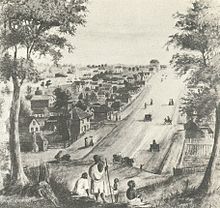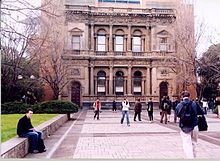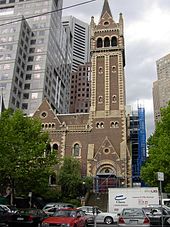- Collins Street, Melbourne
-
Collins Street 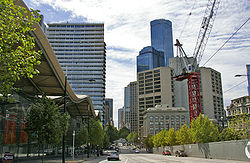
Looking down Collins Street from Southern Cross StationLength: 2 km (1 mi) Location: Melbourne CBD West end: 

 Docklands, Melbourne
Docklands, MelbourneMajor
junctions:
 Spencer Street
Spencer Street
 King Street / Kings Way
King Street / Kings Way
William Street
Queen Street
Elizabeth Street
 Swanston Street
Swanston Street
Russell Street
Exhibition StreetEast end: Spring Street, East Melbourne, Melbourne Collins Street is a major street in the Melbourne central business district and runs approximately east to west.
It is notable as Melbourne's traditional main street and best known street, is often regarded as Australia's premier street,[1] with some of the country's finest Victorian era buildings.
The 'Paris end' (Eastern end) is a part of Marvellous Melbourne mythology. Although modern development has destroyed some of the European flavour of the top-end of Collins Street it still retains its uptown status with its designer boutiques and cafes. The length of Collins Street between Elizabeth and King Streets has long been the financial heart of Melbourne and is home to banks and insurance companies.
Contents
History
As designed by Robert Hoddle, it is exactly one mile in length and 99 feet (one and half chains) wide. Collins Street is named after Lieutenant-Governor David Collins who led a group of settlers in establishing a short-lived settlement at Sorrento on the Mornington Peninsula south of Melbourne in the early 19th century. He subsequently became the first governor of the colony of Van Diemens Land, later to become Tasmania.
Aborigines at Collins Street, Melbourne, 1839. Watercolour by W. Knight
At the western end of the street was Batman's Hill, named for the Tasmanian adventurer and grazier John Batman, who built a house at the base in April 1836, where he lived until his death in 1839.[2]
Throughout the late 19th and early 20th centuries, the top end of Collins Street was dominated by the rooms of medical professionals. The prestigious Melbourne Club was a dominant cultural presence. It was also the location of Grosvenor chambers (9 Collins Street) which was Australia's first custom designed studio complex, and was used by many prominent Australian artists.[3]
Around the turn of the 20th century "doing the Block" became a pastime for shoppers at the Block Arcade area in the retail heart of the street between Elizabeth and Swanston Streets.
The Bank of New South Wales Melbourne office earned architect Joseph Reed a first prize in architecture. When the building was demolished in 1935, the facade was transferred to the University of Melbourne to become the Commerce building, (now administration for the Faculty of Architecture, Building and Planning)
During the 1950s and 1960s, the street became subject to extensive redevelopment and many historic buildings were demolished by Whelan the Wrecker, despite the efforts of the National Trust and the "Save Collins Street" group. While some examples of boom style architecture survive, the grandest examples were lost to the wrecker's ball. Of the major losses, the most significant were the large Victorian buildings including the Federal Coffee Palace, Colonial Mutual Life building, Robb's buildings, Queen Victoria Buildings, City of Melbourne Bank, Scott's Hotel, Melbourne Mansions and APA building.
Between 2003-2005, Collins Street was extended west beyond Spencer Street, and currently ends outside the new ANZ and Myer headquarters further in the Docklands development. It will eventually extend further west in the future, as part of the new redevelopment. This will create an intersection between Bourke Street and Collins Streets, two of Melbourne's most important streets.
Theatres
Collins Street is also home to the Athenaeum and Regent theatres, both of which host Australian and international theatre productions and live performances throughout the year.
Shopping and boutiques
Collins Street is Melbourne's premier shopping street and retailers with flagship stores there include:
- Chanel
- Prada [4]
- Louis Vuitton [5]
- Emporio Armani [6]
- Tiffany & Co [7]
- BVLGARI [8]
- Giorgio Armani
- Ralph Lauren [9]
- TAG Heuer [10]
- Oroton [11]
- Paspaley Pearls
- Harrolds [12]
- Saba [13]
- Henry Bucks [14]
- Dymocks [15]
- Haigh's Chocolates [16]
- Lindt Chocolat Café [17]
Other retailers with a presence on Collins Street include Gucci, Salvatore Ferragamo, Ermenegildo Zegna, Bally, Max Mara, Hermès, Hugo Boss, Dior, Escada, Georg Jensen, Rolex and Jan Logan.
Major shopping centres include Collins Place, Block Arcade, Georges on Collins, Collins 234, Australia on Collins and Centreway.
Major hotels
There are many hotels located on and around Collins Street. Major hotels include Sofitel Melbourne, The Grand Hyatt, Westin and the InterContinental Melbourne at the Rialto. A Sheraton will open in 2013.
Public art
One of the most popular statues in Melbourne, Larry La Trobe created by artist Pamela Irving, faces Collins Street from the northern end of Melbourne City Square.
Architecture
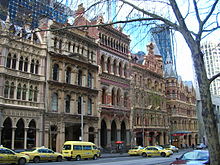 Modern skyscrapers have been deliberately set back from the street in order to retain Victorian era buildings
Modern skyscrapers have been deliberately set back from the street in order to retain Victorian era buildings
As Melbourne's commercial and former shopping centre, Collins Street possesses some of Melbourne's best examples of Victorian era architecture.
Large churches include the Collins Street Baptist Church (1845), the Scot's Presbyterian Church (1874) and the St Michael's Uniting Church (1866).
Significant commercial buildings include Alston's Corner (1914) by Nahum Barnet is an excellent surviving example of Edwardian architecture, while the Block Arcade by D.C Askew (1893) is an excellent example of high Victorian mannerist architecture.
Towards the financial end are some great examples of high Victorian gothic architecture or "Cathedrals of Commerce". They include William Pitt's Venetian Gothic style Old Stock Exchange (1888), William Wardell's Gothic Bank (1883) which features some of Melbourne's finest interiors and A.C Goode House designed by Wright, Reed & Beaver (1891).
The old Commonwealth Bank of Australia Banking domed Chamber exists within the post modern 333 Collins Street tower. It was designed by Lloyd Tayler and Alfred Dunn and built in 1891.
Some of Australia's tallest buildings are along Collins Street, including the Rialto Towers, Collins Place towers 1 & 2, Nauru House, 120 Collins Street and 101 Collins Street and ANZ World Headquarters (at 380 Collins Street, which is integrated into the old Stock Exchange and Gothic Bank).
Institutions
The Melbourne Club is on Collins Street. The renaissance revival style buildings were designed by Leonard Terry and built in 1845.
The Reserve Bank of Australia's Victorian branch is located on Collins Street. Its 1960 buildings were once the national office for the bank.
Most of the global investment banks such as Goldman Sachs and Lazard have their Melbourne headquarters located on Collins Street, with the majority in the prestigious 101 Collins Street. This contributes to the reputation that Collins Street enjoys to this day.
Transport
Trams (routes 48, 109 and 112) also run down Collins Street, mainly to Melbourne's eastern suburbs and the Docklands precinct.
References
- ^ Collins - The Story of Australia's Premier Street. Judith Buckrich ISBN 1740970578
- ^ "Batman, John (1801 - 1839)". Australian Dictionary of Biography, Online Edition. www.adb.online.anu.edu.au. http://www.adb.online.anu.edu.au/biogs/A010066b.htm. Retrieved 2008-07-06.
- ^ see Alex Taylor, Perils of the Studio: Inside the Artistic Affairs of Bohemian Melbourne,Australian Scholarly Publishing & State Library of Victoria: North Melbourne, 2007
- ^ http://www.fashionising.com/forums/t--PRADA-Australia-flagship-store-Collins-Street-3007-1.html
- ^ http://www.collinsstreet.com.au/
- ^ "Collins Street and Little Collins Street, Melbourne". Visit Melbourne. Tourism Victoria. http://www.visitvictoria.com/Regions/Melbourne/Destinations/City-precincts/Collins-Street-and-Little-Collins-Street.aspx. Retrieved 25 July 2011.
- ^ http://au.tiffany.com/Locations/Store.aspx?reasontosignin=8&StoreId=741
- ^ http://www.jewelleryworld.net.au/2008/11/12/article/Bvlgari-opens-flagship-in-Melbourne/IONCCLZAFQ.html
- ^ http://www.vogue.com.au/people+parties/events/ralph+lauren+ store+makeover,1238
- ^ http://www.tagheuer.com.au/tag-heuer-melbourne.html
- ^ http://www.mediasearch.com.au/fashion/spotlights/oroton-boutique_melbourne
- ^ http://www.theaustralian.com.au/news/executive-lifestyle/tom-fords-single-outlet/story-e6frg8k6-1225880103033
- ^ http://www.josephsaba.com.au/More-about-Joseph-Saba.html
- ^ http://www.isis.com.au/OurWork/Retail/HenryBucks/tabid/233/Default.aspx
- ^ http://www.yellowpages.com.au/vic/melbourne/dymocks-melbourne-flagship-12731408-listing.html
- ^ http://haighschocolates.com.au/our_stores/victoria/block_arcade.html
- ^ http://www.realestatesource.com.au/flagship-lindt-chocolat-cafe-to-open-in-collins-street-melbourne.html
Streets of Melbourne's Hoddle Grid Latitudinal streets Longitudinal streets South to North: Flinders · Flinders Lane · Collins · Little Collins · Bourke · Little Bourke · Lonsdale · Little Lonsdale · La TrobeSignificant lanes ACDC Lane · Bank Place · Bligh Place · Block Place · Caledonian Lane · Causeway Lane · Centre Place · Degraves Street · Hardware Lane · Hosier Lane · Niagara Lane · Manchester Lane · McKillop Street · Punch LaneSignificant arcades Block Arcade · Campbell Arcade · Cathedral Arcade · Centreway Arcade · Howey Place · Melbourne GPO · Port Philip Arcade · Royal ArcadeCoordinates: 37°49′00″S 144°57′44″E / 37.8168°S 144.9622°E
Categories:- Landmarks in Melbourne
- Streets in Melbourne
- Shopping districts and streets in Australia
Wikimedia Foundation. 2010.

